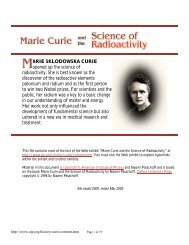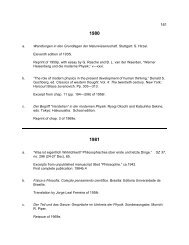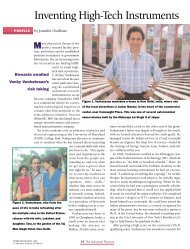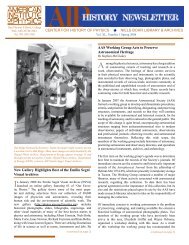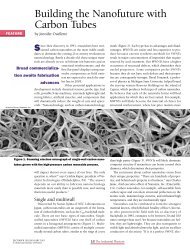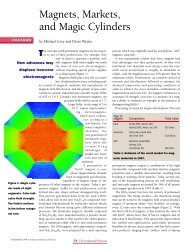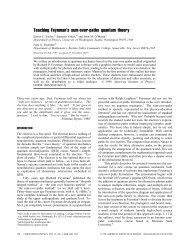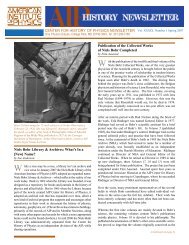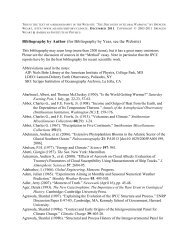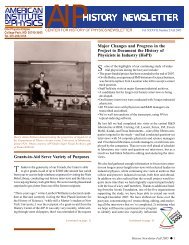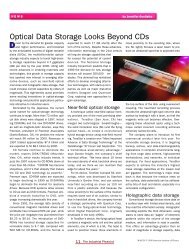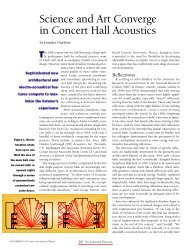Cryptography and the New Economy - American Institute of Physics
Cryptography and the New Economy - American Institute of Physics
Cryptography and the New Economy - American Institute of Physics
Create successful ePaper yourself
Turn your PDF publications into a flip-book with our unique Google optimized e-Paper software.
Te c h n o l o gy<br />
to an individual; <strong>and</strong> certificate authority<br />
(CA), which is <strong>the</strong> industry-established system<br />
that certifies to buyers that an online<br />
business is legitimate.<br />
Until a few years ago, modern cry p t o g r aphy<br />
was <strong>the</strong> exclusive domain <strong>of</strong> pure ma<strong>the</strong>maticians<br />
working for universities, <strong>the</strong> milit<br />
a ry, <strong>and</strong> government agencies. When <strong>the</strong><br />
business world embraced encryption, we<br />
began hearing acronyms such as PKI <strong>and</strong> CA .<br />
In fact, cryptography has emerged as one <strong>of</strong><br />
<strong>the</strong> hottest areas in so-called enterprise computing.<br />
To d a y, some <strong>of</strong> <strong>the</strong> largest conferences<br />
in mainstream computing are on cry pt<br />
o g r a p h y. The RSA Conference, <strong>the</strong> Entrust<br />
SecureSummit Conference, <strong>and</strong> <strong>the</strong> Certicom<br />
Public Key Solutions Conference are ex a mples<br />
<strong>of</strong> annual events at which thous<strong>and</strong>s <strong>of</strong><br />
people ga<strong>the</strong>r to discuss cry p t o g r a p h y.<br />
Many number <strong>the</strong>orists once boasted<br />
that <strong>the</strong>y could see no possible way that <strong>the</strong><br />
purity <strong>and</strong> beauty <strong>of</strong> <strong>the</strong>ir research area<br />
could ever be tainted by military or com-<br />
mercial applications. Unfortunately for<br />
<strong>the</strong>m, <strong>the</strong> adoption <strong>of</strong> number <strong>the</strong>ory to<br />
c ryptography represents perhaps <strong>the</strong> most<br />
pr<strong>of</strong>ound integration <strong>of</strong> abstract <strong>the</strong>ory into<br />
everyday life in recent history.<br />
Everyday applications<br />
To appreciate <strong>the</strong> impact <strong>of</strong> cryptography<br />
on daily life, one needs to better underst<strong>and</strong><br />
some <strong>of</strong> its key commercial applications.<br />
Internet sales <strong>and</strong> mobile commerce<br />
are two prominent examples.<br />
Most reputable players in Web-based ecommerce<br />
share a common framework <strong>of</strong><br />
cryptographic protocols. Many use a protocol<br />
known as <strong>the</strong> Secure Socket Layer (SSL),<br />
which Netscape pioneered for e-commerce.<br />
This particular protocol has enabled many<br />
transactions to take place online, from <strong>the</strong><br />
simple purchasing <strong>of</strong> goods to banking <strong>and</strong><br />
bill paying. Through SSL, users can positively<br />
identify a Web site as being reputable<br />
<strong>and</strong> know that <strong>the</strong>y are sending confidential<br />
information, such as credit card numbers,<br />
through a secure, encrypted system.<br />
SSL is a variation <strong>of</strong> public-key encry ption.<br />
It uses RSA-based digital signatures,<br />
which are analogous to a personal signature,<br />
to identify online users. The s<strong>of</strong>tware for SSL<br />
is typically embedded in computer browsers<br />
<strong>and</strong> <strong>the</strong> server s<strong>of</strong>tware <strong>of</strong> e-commerce sites.<br />
Supporting <strong>the</strong> RSA routines is <strong>the</strong> DES<br />
s y m m e t r i c - e n c ryption scheme, which performs<br />
<strong>the</strong> actual encryption <strong>of</strong> credit-card<br />
numbers or o<strong>the</strong>r data. In most <strong>of</strong> <strong>the</strong><br />
world, <strong>the</strong> DES encryption strength is 56<br />
bits (<strong>the</strong> number <strong>of</strong> bits indicates <strong>the</strong> size <strong>of</strong><br />
<strong>the</strong> key; <strong>the</strong> more bits, <strong>the</strong> stronger <strong>the</strong><br />
e n c ryption power). However, <strong>the</strong> National<br />
<strong>Institute</strong> <strong>of</strong> St<strong>and</strong>ards <strong>and</strong> Technology will<br />
soon announce a new st<strong>and</strong>ard called <strong>the</strong><br />
Advanced Encryption St<strong>and</strong>ard, which has<br />
a strength <strong>of</strong> 128, 192, or 256 bits.<br />
A recent e-commerce phenomenon<br />
involves <strong>the</strong> convergence <strong>of</strong> Internet access<br />
with small <strong>and</strong> <strong>of</strong>ten wireless devices such



